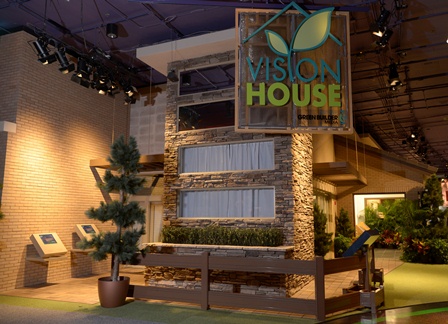- Green Builder® Coalition Produces Webinar Series on the SAVE Act
- Green Builder® Coalition Members Receive Special Recognition
- Executive Director to Appear on Home Talk USA
- As I Am… Tom Miller
- Project Profile – New Green Home Exhibit to Reach Millions
- Job Opportunities
- Train of Thought
Activities
Green Builder® Coalition Produces Webinar Series on the SAVE Act

The final webinar in the 3-part series on the SAVE Act will occur on Tuesday, May 1st at 11am CT. Titled “SAVE Act: Financing Options & Real Estate Ramifications”, Green Builder® Coalition Chairman Ron Jones will moderate a panel that includes Bob Sahadi (Institute for Market Transformation) and Dr. John Beldock (EcoBroker).
On Wednesday, March 14th, the Green Builder® Coalition and Green Builder® Media presented an informational and thorough look at the SAVE Act. Moderated by Ron Jones, he was joined by Ken Gear (Leading Builders of America) and Philip Henderson (Natural Resources Defense Council) as they examined all aspects of the SAVE Act. Then, on April 4th, Ron Jones spoke with C.R. Herro (Meritage Homes) and Chad Ray (Olde Heritage Builders & Realty) about how the legislation would affect builders and remodelers.
A bipartisan duo of US Senators want to improve the accuracy of America’s appraisal and mortgage underwriting. Senators Michael Bennet (D-Co.) and Johnny Isakson (R-Ga.) introduced The Sensible Accounting to Value Energy (SAVE) Act (S. 1737) on October 19, 2011. Developed over the course of many months and garnering strong support from appraisers, builders, manufacturers, environmental groups and many others, the legislation aims to improve the accuracy of mortgage underwriting used by federal mortgage agencies by ensuring that energy costs are included in the underwriting process.
To register for this educational webinar, please click here.
To view past SAVE Act webinars, please click here.
Produced by: Green Builder® Coalition and Green Builder® Media
Sponsored by:
Green Builder® Coalition Members Receive Special Recognition
We are very proud to share that two of our members, Chad Ray and Maria Kingery, have recently been bestowed special recognition for their work towards a more sustainable planet.
Chad and Jodi Ray were two of eight individuals honored at the White House as “Champions of Change” for demonstrating that corporate environmental leadership make senses, both for business and for American communities.
“Cutting waste, reducing energy use and operating more sustainably translates to less pollution and lower utility bills for businesses across the country,” said Nancy Sutley, Chair of the White House Council on Environmental Quality. “The leaders we’ve selected as ‘Champions of Change’ are proving that sustainable practices work for companies’ bottom lines, and work for the health of American communities.”
The “Champions of Change” program was created as a part of President Obama’s “Winning the Future” initiative. Each week, a different sector is highlighted and groups of Champions, ranging from educators to entrepreneurs to community leaders, are recognized for the work they are doing to serve and strengthen their communities.
Chad and his wife, Jodi, launched a sustainable farm venture to provide safe, delicious and affordable food in the Raleigh, NC area. They have committed to environmental stewardship throughout their business, whether in farming, construction or educating all age groups about the importance of animal welfare, heritage livestock breeds and environmental stewardship. They believe in the triple bottom line of people, planet and profit; and that long term economic vitality starts with a commitment to our world’s natural resources.
Maria Kingery co-founded Southern Energy Management (SEM) in 2001 with her husband, Bob. Their firm has been named an inaugural NAHB Research Center Green Partner of the Year for 2011.
“This is the first year since the Research Center began offering certification services to the National Green Building Standard (NGBS, ICC-700) that we have presented awards to our program partners,” Research Center President Michael Luzier said. “We are awed by what companies like SEM are achieving in the field and the market transformation they are accomplishing through a voluntary, market-driven program.”
Southern Energy Management is the number one verifier in the United States, accounting for 23 percent of NGBS homes nationwide, based on statistics released in 2011. Its NAHB Research Center-accredited staff performed nearly 300 field verifications in 2011 alone. The residential building performance team at SEM has consistently been recognized as an industry forerunner, working with builders and homeowners to promote green building practices, energy efficiency programs and home performance improvements. In 2011, SEM helped its clients prevent more than 16-million pounds of carbon dioxide emissions through its residential building performance services.
Appearances
eXecutive Director to Appear on Home Talk USA
At 5:30pm CT on Saturday, June 16th, Executive Director Mike Collignon will be a guest on Michael King’s radio show, Home Talk USA. They’ll be discussing the Green Builder® Coalition, as well as green building products & tips that any new or existing homeowner can use to save money. They’ll also be taking listener questions live on air.
“The Cajun Contractor” broadcasts his show on over 200 radio affiliates in all 50 states. Now in its 8th year, Home Talk USA discusses many topics concerning home improvements, introduces the consumer to new and innovative products, provides access to industry experts, protects homeowners from consumer fraud, holds the home improvement industry accountable for its business practices, and advocates for a fair and mutual relationship between the consumer and the contractor.
For more information about Home Talk USA, please click here.
As I Am…
 Tom Miller
Tom Miller
Each issue, we’ll sit down with a green building professional to gain a personal insight into their motivations, inspirations and experiences. This issue, we feature Tom Miller, Founding Partner and Principal at Miller Brooks.
The Torch: What motivated you to enter the sustainability industry?
Tom Miller: I was in college when the first Earth Day was launched. Buckminster Fuller was also teaching a class in the architecture school, and it was open to students to audit for no credit, which I did. It was an eye-opening experience. There was a lot of energy and debate around environmental issues. That’s when I was introduced to books like Silent Spring and Small Is Beautiful. And because several of my friends were in the architecture school, I was caught up in the debate about the environment.
After graduating, I worked for a company that made conveyor systems for the emerging recycling industry. The closer one gets to the immensity of the solid waste situation, the more overwhelming the magnitude of the issue becomes.
TT: Describe your first green project. Did you encounter any hurdles on that first project? (If yes, how did you overcome them?)
TM: In 1979 my wife and I moved into our first home. And a few months after moving in we installed solar panels for hot water. The panels were mounted on the garage roof, and the pumps were installed in the garage. Lots of hot water… until January. Then the pumps froze, pipes burst. Not a pretty scene.
TT: What building product or technique do you think will be the next “game changer”?
TM: I don’t think there is any one product or technique that will be the game changer. Buildings are a complex system comprised of many sub-systems, not all that different from the human body. They require thoughtful design, careful attention to construction detail and plenty of TLC to keep them functioning.
Buildings seem to have a biology all their own. When all of the systems are functioning in harmony it is a beautiful thing. I think that the real game changer is taking a building science approach to buildings. Just as medical science has been a huge boon to humans, building science can have the same positive impact on the built environment.
TT: Who inspires you the most?
TM: When it comes to sustainability and environmental issues, there are so many people who I consider mentors and teachers…some I know personally, while others I have only met through their writings. Rachel Carson, the author of Silent Spring; E. F. Schumacher, author of Small is Beautiful; Buckminster Fuller, Jared Diamond, Wendell Berry and Edward Abbey are just a few. Personally, the list includes Roger Clearman, Ray Dick, Ron Jones, Rick Davenport, Allison Bailes, Mark Laliberte, Colin Fletcher and other building scientists who continually contribute to the wealth of knowledge about how buildings function best.
TT: If you had it to do over again, what profession would you choose?
TM: No complaints about my role in communicating the importance of sustainability. Second choice would most definitely be architecture.
TT: What do you enjoy the most when you’re not at work?
TM: Anything that involves being outdoors, walking (not including concrete, asphalt etc.), with a little wind and some heavy weather. Scotland is first choice…or anyplace in the Rockies.
TT: What’s the most important piece of advice you’d like to pass along to others?
TM: If you want to go the distance over rugged terrain (mental or physical…or both), find a comfortable pace and stick with it.
Project Profile
New Green Home Exhibit to Reach Millions
Sara Gutterman and Ron Jones of Green Builder® Media have collaborated with Walt Disney Imagineering to create the VISION House® in INNOVENTIONS, an innovative green home exhibit located in INNOVENTIONS at Epcot® at the Walt Disney World® Resort. The informative demonstration project was unveiled on Earth Day, and will be on display for years to come.
The purpose of the VISION House® in INNOVENTIONS is to present green living ideas in a fun and informative manner that will empower guests with the knowledge that a sustainable future is possible. The exhibit will showcase a wide spectrum of environmentally appropriate products and options and provide homeowners with real solutions for contemporary green living.
 “Sustainable living is about taking personal responsibility,” says Green Builder® Media CEO Sara Gutterman. “Through the VISION House in INNOVENTIONS, we will illustrate that we can all provide our families with necessities like sustenance, and shelter, as well as comfort and convenience, while simultaneously preserving and protecting the environment.”
“Sustainable living is about taking personal responsibility,” says Green Builder® Media CEO Sara Gutterman. “Through the VISION House in INNOVENTIONS, we will illustrate that we can all provide our families with necessities like sustenance, and shelter, as well as comfort and convenience, while simultaneously preserving and protecting the environment.”
As guests take a guided tour of the VISION House®, they will explore the major themes of green building, such as whole-home automation; energy generation and efficiency; water conservation; indoor environment quality; and high-performance materials and durability. Along the way, they will encounter intelligent products and advanced technologies, such as:
• High efficiency heating and cooling systems and controls and innovative whole-home automation system and door hardware by Ingersoll Rand
• Electronic vehicle charging station by SIEMENS
• Chevy Volt electric vehicle by GM
• Photovoltaic solar panels from Hanwha Solar
• Durable and environmentally friendly exterior systems, including smog-eating tile roofs, cultured stone, bricks, permeable pavers, and trim by Boral
• Ventilation solutions to improve indoor air quality by Panasonic
• Energy efficient windows and doors from Pella
• High performance glass products by Schott
• Fire sprinkler information from the National Fire Protection Association
• Sustainable hardwood flooring and cabinets from Armstrong World Industries
• Water-conserving fixtures, faucets, showerheads, and home standby generators by KOHLER
• ENERGY STAR certified home appliances by Bosch
• LED lighting solutions by SYLVANIA
The VISION House® in INNOVENTIONS is a part of Green Builder® Media’s VISION House Series. These actual residences around the country are designed to demonstrate that a successful building is more than simple shelter – it is an interactive set of systems that combine to create a truly green living environment for inhabitants.
For more information about the VISION House® in INNOVENTIONS, visit visionhousegreen.com.
Job Opportunities
Below you will find job postings for green collar jobs around the country.
If you have a job opening you’d like to list here, please contact the Green Builder® Coalition at info@greenbuildercoalition.org.
CLEAResult (www.clearesult.com), an energy-optimization firm that designs and implements programs to help utilities manage load growth by helping customers identify energy-savings opportunities and implement energy-efficiency improvements, is currently hiring seasoned energy-efficiency engineers with commercial & industrial energy-auditing experience. These are full-time positions with full benefits.
Among other things, qualified engineers should have experience conducting building energy-use audits/analyses, identifying energy-efficiency opportunities, using energy-simulation/modeling tools such as DOE-2/eQUEST, performing energy-savings calculations, and developing measurement and verification (M&V) plans. P.E. and/or C.E.M. certification is preferred.
The openings are located in various cities across the U.S. Our offices are located in the following cities: Atlanta, Austin, Boston, Columbus (OH), Dallas, Detroit, El Paso, Houston, Lansing (MI), Las Vegas, Little Rock, New Orleans, Oklahoma City, Portland (OR), Reno and Washington, D.C.
If you are interested in any of the above job openings, please contact:
James Hatheway
Recruiter
(512) 259-2383
jhatheway@clearesult.com
Or apply via this website: www.clearesult.com
The Southeast Energy Efficiency Alliance (SEEA; www.seealliance.org) is a 501(c)(3) nonprofit with the mission of promoting and achieving energy efficiency through networking, program activities, and education. They are looking to fill the following position:
Energy Policy Associate: Support SEEA’s Public Policy Team, and engage with building officials, contractors, policy makers and other stakeholders to promote the adoption and implementation of energy codes in the Southeast in order to promote a stronger economy and higher quality of life for residents and businesses in the region. This position will also assist with the implementation of energy efficient opportunities and the strategic goals and objectives of SEEA’s public policy portfolio.
This position is based out of SEEA’s main office in Atlanta, Georgia. Up to 40% of time may be required for travel in the Southeastern region and beyond.
College degree required, graduate degree preferred. At least a year of relevant professional experience is required for this position. SEEA is an Equal Opportunity Employer.
Salary range will be $35,000-$45,000. Salary offer will be competitive and commensurate with qualifications of successful applicant. SEEA offers a generous and comprehensive benefits package.
All qualified candidates may apply by sending a cover letter and resume to jobs@seealliance.org with the subject line: Energy Policy Associate. No phone calls please.
The Pacific Northwest National Laboratory currently has 52 jobs listed on their site. Most are located in their home state of Washington, though 5 of the posted positions are based in College Park, MD. If you have any interest in these highly scientific roles, please visit their career site by clicking here.
Any listing above does not constitute an endorsement by the Green Builder® Coalition. We do not have any professional or financial stake in the preceding information. Rather, we provide this solely for the benefit of those seeking employment.
Voices
 Train of Thought
Train of Thought
Have you ever watched something happen, right in front of your eyes, that you never thought you’d see? Being a sports fan, events like the 1980 “Miracle on Ice”, the New York Giants victory in Super Bowl XLII or Game 6 of the 2011 World Series easily come to my mind.
But, to keep it germane to the building industry, I really didn’t think I would see a membership organization completely ignore its own members. Yet, in my opinion, that’s exactly what happened with the final version of the inaugural International Green Construction Code (IgCC). I was in the room in Phoenix with hundreds of my fellow industry associates when the voting members of the International Code Council (ICC) decided to eschew low-rise residential in the IgCC. Obviously, I was disappointed, as we had worked with other industry organizations (USGBC, Mathis Consulting, Southern Nevada Water Authority and ICC staff) to get it re-introduced into the new green code. With the assistance of ICC staff, our code development group had gone so far as to compile its own, independent low-rise residential document, written in code language.
And here I thought that was the end of the matter. Well, until the next code cycle, because we had just completed the final action hearings. How foolish of me!
Approximately one month after the conclusion of those “final action” hearings, the ICC had a Board meeting. (While ICC claims these are open to the public, they do a very poor job of communicating when and where they occur. Follow the ICC on Twitter and you’ll get ample opportunities to read the same stories about their Foundation’s work, or a recent retirement of a long-time code official, but no notice about these “public” Board meetings.)
At the December ICC Board meeting, the National Association of Home Builders requested the “removal of multifamily housing” from the IgCC. (You can read NAHB’s internal article here, and download their letter to the ICC president here.) This would strip the IgCC of even more impact than it had already lost. Thankfully, this didn’t happen, but what did occur is even more baffling.
The ICC Board decided to reverse their own members vote in Phoenix and include all residential as a jurisdictional option under the IgCC. On its face, this might seem like a good thing. But context is needed, as there are deep politics at work here.
When the ICC Board made their decision, they were simultaneously: a) trying to have it both ways, b) stuck between a rock and a hard place, and c) hoisting the proverbial middle finger at their voting members. I’ll briefly break down each one of these.
The ICC was feeling pressure from all sides. In one ear, they’ve got NAHB (amongst others) virtually saying, “Don’t do anything for residential structures, because we fight environmental progress at every turn.” In the other ear, they’ve got USGBC, Green Builder® Coalition and others saying all residential structures need to have a place within the IgCC. By referencing NAHB’s National Green Building Standard (NGBS), I mean, ICC 700, they feel they can appease everyone. But this was really the easiest way out of a sticky situation.
Why? Thanks to a private MOU between the ICC and NAHB, the ICC is beholden to NAHB in ways few people know. Low-rise residential, as viewed through the IgCC lens, is a jurisdictional option. It requires only the base minimum performance of the NGBS, with the exception of adherence to the 2012 IECC, because anything less would be in violation of the current energy code.
Sadly, it gets worse. NAHB has an inordinate amount of influence over ICC 700. They facilitate the periodic updates, they appoint many of the hearing committee members, and thanks to a committee restructuring within ICC, they now hold 1/3 of the seats on the Residential Energy Committee. That noise you hear is the dragging of heels, anchors and any other heavy, inanimate object to help slow and/or stop the engine of increased energy performance.
Finally, I can’t fathom what the voting members of ICC must feel now. Can you imagine if you were a member of an organization that was established to represent and further your professional opinion/voice, and then saw it completely ignore the recommendation of you and scores of your colleagues? I openly wonder if the International Association of Building Officials has seen an increase in memberships in the past two months.
Something is better than nothing, so on some level I’m pleased to see there’s at least a passing reference to improving the sustainability of residential structures. However, for those who haven’t been paying close attention, you can see why I’m not jumping on the celebratory IgCC bandwagon that ICC is trying to generate through the conventional and social media.
Log on to our Facebook page and share your thoughts.





